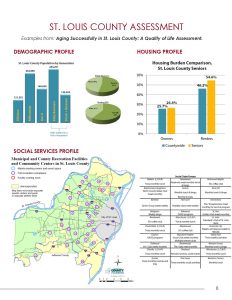Community Needs Assessment



Developing a comprehensive assessment serves several purposes for action towards advancing an age-friendly community.
First, it evaluates the community in its current state and provides data-driven feedback.
Second, it identifies assets, areas for improvement, and gaps.
Third, it helps establish standards for a community and evaluate progress.
Fourth, it motivates performance and helps to develop a game plan for the future.
WHAT ARE THE COMPONENTS OF AN ASSESSMENT?
A strong assessment will include both internal and external components. The internal piece of the assessment will include a review of the municipal programs, services, and amenities currently offered to older adults. Understanding what you already offer to older adults will help you plan for future programs and services that either expand upon successes or fill in gaps for service delivery. The external piece of the assessment evaluates all of the components that contribute to an age-friendly community, but are not directly delivered by your municipality.
HOW CAN THE ASSESSMENT BE USED?
After you have completed your assessment, it should result in a set of recommendations. These recommendations can be used to help guide future policy and programming as it relates to building your age-friendly community. You will also use your assessment to share information about the community with residents and stakeholders. Your assessment will be a data rich resource for understanding some of the age-friendly strengths and weaknesses of your community.
ASK
What does the community identify as priorities for becoming an age-friendly community? *
What issues in your community do you think are most important or relevant for age-friendliness?
Do your policies reflect the needs of a diverse older adult population?
Do your programs reflect the needs of a diverse older adult population?
* St. Louis County used a four-pronged approach organized around the WHO 8 Domains of Livability: Health & Wellbeing, Social & Civic Engagement, Mobility & Connectivity, and Safe & Attractive Neighborhoods
RESEARCH
Create a demographic profile of your older adults:
•Population
•Gender
•Race
•Household composition
•Income
Source: US Census data, stratified by age** (45-64; 65+)
Create a profile of the housing stock in your community
•Homeownership
•Housing affordability
•Residential living facilities
Source: American Community Survey, stratified by age** (45-64; 65+)
Create a profile of the social services available within your community:
•Social and Recreational Programs
•Housing Programs
•Police-Citizen Programs
•Volunteerism
•Emergency Preparedness
•Facilities (Recreational & Community Centers, Libraries, Designated Senior Centers, Health care, Transit stops/lines)
EVALUATE
Are there gaps municipal services could fill for older residents in the landscape of service?
Are services for residents that other agencies are providing that municipal services duplicate?
Are there any municipal services provided that are underutilized or not needed?
Main target group: Older people in general
Sector(s): Education, Health, Housing, Information and communication, Labor, Long-term care, Social protection, Transportation
Desired outcome for older people:
Meet their basic needs